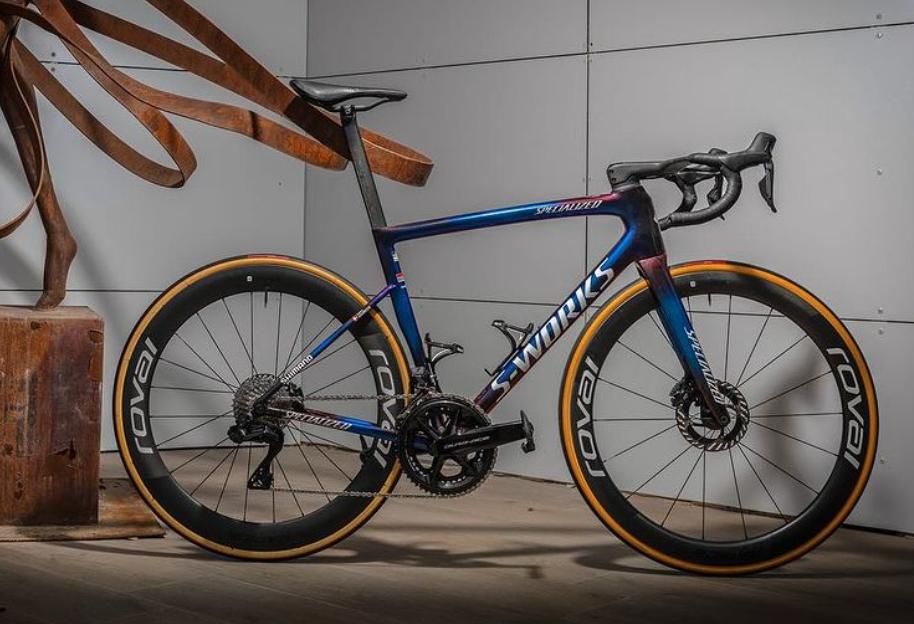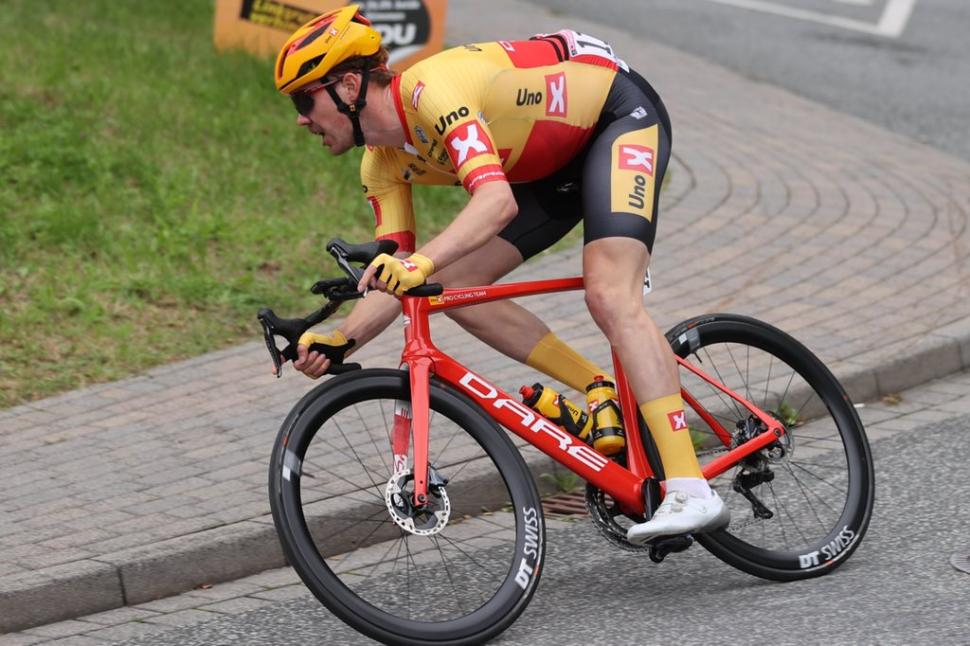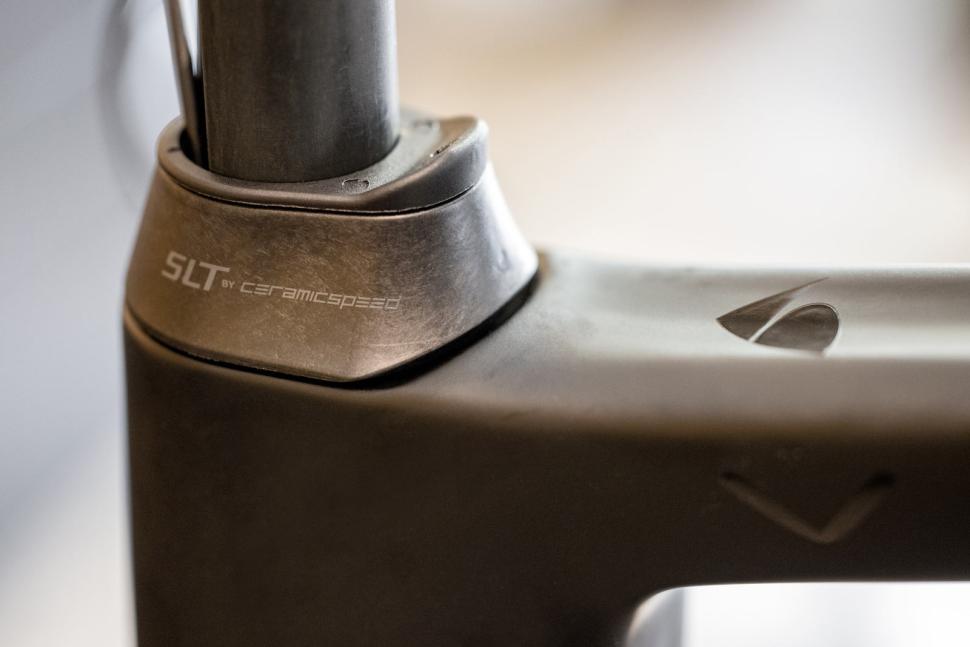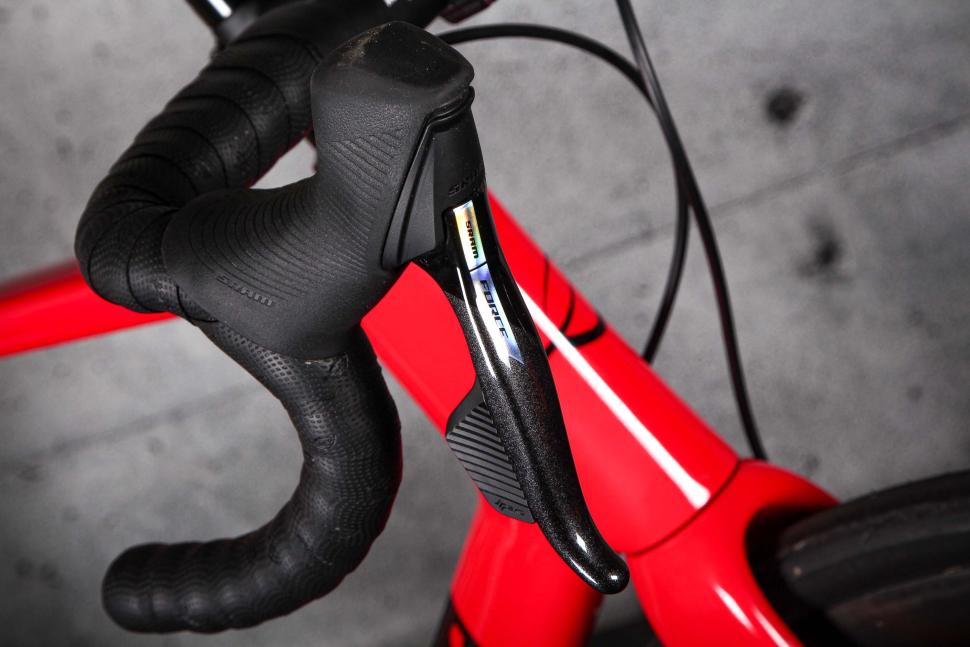- News
- Reviews
- Bikes
- Accessories
- Accessories - misc
- Computer mounts
- Bags
- Bar ends
- Bike bags & cases
- Bottle cages
- Bottles
- Cameras
- Car racks
- Child seats
- Computers
- Glasses
- GPS units
- Helmets
- Lights - front
- Lights - rear
- Lights - sets
- Locks
- Mirrors
- Mudguards
- Racks
- Pumps & CO2 inflators
- Puncture kits
- Reflectives
- Smart watches
- Stands and racks
- Trailers
- Clothing
- Components
- Bar tape & grips
- Bottom brackets
- Brake & gear cables
- Brake & STI levers
- Brake pads & spares
- Brakes
- Cassettes & freewheels
- Chains
- Chainsets & chainrings
- Derailleurs - front
- Derailleurs - rear
- Forks
- Gear levers & shifters
- Groupsets
- Handlebars & extensions
- Headsets
- Hubs
- Inner tubes
- Pedals
- Quick releases & skewers
- Saddles
- Seatposts
- Stems
- Wheels
- Tyres
- Health, fitness and nutrition
- Tools and workshop
- Miscellaneous
- Buyers Guides
- Features
- Forum
- Recommends
- Podcast
feature
 Cable Routing Jan 2024
Cable Routing Jan 2024Has the move to full internal cable routing on road bikes been worth it? We asked some experts to weigh in on cycling's cable-tidy revolution
Bikes with internal cable routing looks super slick and cleaner than the most minimalist of whistles. But beyond the aesthetics has the move to full internal cable routing really been worth all the extra hassle we're told it comes with? We talked to industry experts, from aerodynamicists to framebuilders and WorldTour mechanics, to find out…
The cycling establishment
Miles Hubbard is road product manager at biking behemoths Specialized
road.cc: Do you have data showing the drag-reducing claims of internal cable routing?
MH: We’ve studied the effect of exposed cables on drag since the inception of our Win Tunnel [Specialized's own purpose-built wind tunnel]. We don’t just integrate cables for the clean aesthetics. It does look great, but it also makes a difference for aerodynamics. Over 40km, hiding a pair of brake lines saves around six seconds at 45kph.
How do you perceive how easy, or not, it is for the home mechanic to work on internal routing?
We work on our bikes at home, too. We get it! We strive to make our bikes with integrated cables as easy to work on as we can, but it’s no secret that integrated cables require extra effort to maintain over time and that’s not a worthwhile feature for all riders. That’s why we make plenty of bikes with standard cable routing, too.
Any advice for road.cc readers (and the staff) regarding internal cable-routing jobs?
When it comes to bikes that are integrated, here are few helpful thoughts to bear in mind…
- For two-piece integrated cockpits, it’s useful to hide the brake hoses under the stem, not through the stem. The Tarmac SL7 stem is a good example of a system that neatly hides the cables while keeping simple fit changes like stem swaps easy. You won’t have to cut hydraulic lines and re-bleed brakes for most stem swaps.
- When it comes to travelling with an integrated cockpit, bikes that have a small amount of brake line hidden beneath the stem make it easier to remove the cockpit and pack in most travel cases. The SL7 stem and Roval Rapide cockpit are good examples of integrated bike designs that make travelling with an integrated bike easier.
With the WorldTour starting in Australia – the Tour Down Under – when you introduce a new bike to a team, do you show them how to maintain it? This is especially true of internal cable routing
As long-term partners we have great relationships with our teams [Soudal Quick-Step and Bora-Hansgrohe], and work closely with the mechanics and athletes when new bikes and equipment are introduced. Our bikes have had integrated cables for several years now, so for our teams and pro mechanics it’s about as simple as changing a tyre. They are experts.
The race mechanic
Klas Johansson is an experienced mechanic at the top level. His current team is Norwegian UCI ProTeam Uno-X Mobility, who harbour ambitions to make the WorldTour, an experience Johansson’s already enjoyed with the likes of MTN-Qhubeka, Israel Start-Up Nation and Lotto-Soudal
What’s your experience of internal cable routing?
KJ: Currently, our bikes are from DARE, which is a Taiwanese bike company, but I’ve worked with so many other bike brands including BMC, Ridley and Factor. They were okay to work with but DARE’s the easiest – maybe a round fork helps as the others were all with square or similar forks – albeit they’re all time consuming. Then again, us race mechanics are dealing with just one brand of bike. I can’t imagine how tough it must be if you’re a bike shop mechanic and one minute you’re working on a Canyon and the next a Cervélo. I imagine the customer’s a little surprised when they get the bill as these things take time.
At a Grand Tour is it common to have cable routing issues?
No. In fact it’s less likely than any race because so much preparation work goes into a race like the Tor de France or Giro d’Italia. If a bike had a shitty headset or similar, you’d discover and sort the problem at the service course. Then again, if you have to change the headset, say, at the Tour, it’s easy. You might be able to do it in the truck, with decent light and a nice temperature. That’s not the same at a race like Paris-Nice where it’s often raining, windy and you’re stuck outside. You also have rest days for repair jobs and more mechanics.
So, you don’t awake in a sweat dreaming of a return to external cable routing?
No. Anyway, the industry’s decided it’s not going to happen. And this is now part of what we do. You learn to work with the specific frame, the specific headset, the specific fork… and work out little tricks to speed up the process. Still, a full internal cable routing change can take an hour and a half.
Any tips you can offer our readers?
Not tips but hope! With Uno-X Mobility we have CeramicSpeed as a sponsor. In November a representative of CeramicSpeed visited us and introduced what I feel could be a gamechanger. Let me explain… we often have to change headsets, which is always a pain when internally routing cables. CeramicSpeed’s created a headset, the SLT, that features a polymer plastic base and stainless-steel balls that are self-lubricating. Also, they are sealed superbly, making it almost impossible for water or contaminants to penetrate. If it works it’ll be revolutionary. And I’m sure it will as they’re also using it in the rear suspension of mountain bikes, which deals with a load of shit. I’m sure other companies will follow their lead.
Marginal gains: the aero expert
Dr Xavier Disley heads up Droitwich-based aero aficionados AeroCoach. What Disley doesn’t know about cutting drag isn’t worth knowing. We simply asked Disley if he’d looked into the aerodynamic benefits (or not) of internal over external cabling…
“We’ve done stuff in the tunnel and on the track around cables, but it’s difficult to get rid of them on a bike that doesn’t have the capacity to remove things entirely, so we can use some of that tidying data along with calculations.
“CdA is the drag value we’re looking to establish for a cable. As long as the cable isn’t doing something exciting like acting as a splitter over a shape behind it, then removing the cable will reduce the CdA of the bike.
“CdA is made up of two components – the Cd (drag coefficient) and the A (frontal area). Cd represents how aero the shape is, so an airfoil shape will have a lower Cd than a flat plate; the A is just the silhouette of the object. A cylinder will have a Cd of roughly 0.5; we can establish a baseline for the frontal area by taking something like a 5mm brake outer, multiplied by a typical exposed length that is dead on to the airflow (around 130mm for handlebar to front rim brake for example).
“That gives us a CdA for an exposed 130mm brake cable of 0.000325m^2. At 45kph this is equivalent to around 0.4 watts. If you have four of these cable sets at the front of the bike, then you’re looking at around 1.6 watts in total.
“When we’ve tested it on the track or in the tunnel, we’ve never seen more than a two-watt saving on a higher-end bike and sometimes none at all, which matches up with the calculation and also margin for error. At a lower speed – say 30kph – this 1.6 watts at 45kph is reduced to around 0.5 watts, so not a lot. But any advantage is worth having, of course."
A bike brand going against the grain
Icelandic brand Lauf is known for its gravel bikes. But Reykjavik’s finest launched its first road bike, the Úthald, at the end of last year, promising “aero where it makes sense”. That meant bucking the trend for internal cable routing, stating that “fully internal routing is mostly an aesthetics thing, best served to cyclists that find it difficult looking at brake hoses entering bike frames”. Here’s Lauf CEO Benedikt Skulason to explain why…
What do you see as the main benefits of external over internal cabling?
BS: We wanted to ‘optimise’ Úthald to make you faster. That clearly meant prioritising the ease of fit-changes, travelling, servicing and reliability. We prioritised that over the less-than-a-single watt of potential savings of fully hiding a pair of brake hoses from bar to frame/fork.
Have you seen any studies showing internal cable routing reduces drag compared to external?
Yes, but the ones we’ve seen are flawed; in other words, we don’t feel they resemble real road-bike riding. They don’t explicitly lie. But through presentation discreteness and skill, they do. They exaggerate the drag of external cables by all possible means, giving you a massively inflated number. That high number is left in your head as the key takeaway message and only then, to maintain credibility and to keep it “honest”, they subtly tell you that this number is in extreme circumstances. They look to avoid drawing attention to the fact that their inflated number is not just too high, it’s an order of magnitude too high!
How do companies inflate the drag?
In my opinion, there are five ways…
1) Testing done with four cables – in other words, non-wireless shifting – rather than two as seen on modern, wirelessly shifting high-end road bikes.
2) Neglect the required larger frontal area of a fully internally routed bike frame. (To house a larger upper headset bearing, the headtube needs to be bigger.)
3) Testing done without a rider on the bike. This is a simplification that exaggerates the drag of the cables. Including a rider would reduce the system’s overall ‘drag addition’ caused by an object upstream of the rider, as a given air molecule pulled along by the cables is likely going to hit the rider behind it at a lesser speed than what it otherwise would have done. Not including a rider in testing is incorrectly assuming that air pulled along by cables would never have gone on to affect the rider. A parallel example of this phenomenon that some might remember is testing that surprised many by showing that a beard added minimal drag. That beard would certainly have been shown to add significant drag if it had been tested without its owner resting behind it.
4) Testing is generally done at unrealistic speeds, without attempts to explain how (extremely!) misleading that is. Power required to sustain a certain speed against the wind grows to the power of three. So, if we assume someone claimed 1W saved at 45km/hr, then the savings become, at 35km/hr (TT-style, no-drafting) 0.47W, and at 25km/h (TT-style, no-drafting) 0.17W. That’s minimal to say the least.
5) It skews results further to focus on time-trial riding values where any aero benefits are greatly exaggerated compared to road riding where riders frequently draft other riders.
Are you concerned that cyclists will be put off the Uthald because of your cabling choice?
Yes, it would be hard to go against the stream like that on an all-in aero bike. However, the point with our Úthald was to make a road bike that would make you as fast as possible. Regardless of labels. Optimising a single ‘tool’ to gain speed (aero in this case) is another way of saying you're turning a blind eye to other things you might be sacrificing that’d eventually make you faster. On Úthald we do aero where we can, while also preserving other things we like.
The master framebuilder
The Campag Kid – aka Alan – is a cycling enthusiast and online sensation who’s built a cult following by restoring and building Campagnolo-equipped bikes
It’s a big subject, but what are your general thoughts on internal cable routing?
CK: Manufacturers have come up with dream bikes where you cannot see any cables. But the build time for these bikes is phenomenal. It’s why buying framesets is now rare. Imagine the rider who buys a frameset from Specialized, Colnago or Pinarello and has to work out how to manage hydraulic cables and the electrics.
Things have changed somewhat then!
Beyond the pale. At the beginning, frames were nearly bare as you didn’t have derailleur gears. When cables came in, they were bolted on [to the frame] with clips. This was around the 1940s and 1950s. Framebuilders then started to braze clips on, which changed the process of building a bike because you were thinking about cables from the start.
In the early to mid-1980s, bike companies started experimenting with putting the brake cables through the handlebars. This was the start of internal cabling. That was a real breakthrough, but the frames themselves stayed with external cabling. That was especially true of carbon bikes because manufacturers were understandably concerned with putting holes in their shiny carbon frames, this being before the detailed computer analysis that’s seen in today’s frame design. That changed well over a decade ago thanks to the likes of Colnago, albeit electronic gear shifting systems made things even more complicated.
> The Campag Kid on the road.cc Podcast
Wiring a frame with Shimano Di2 or Campagnolo EPS wiring is a nightmare. If you ever get a problem and you damage the charging port, for instance, you’ve got to rewire the bike, which means stripping it right down. Which means you’ve got to start fishing around inside with special cable kits.
Don’t get me wrong, I love EPS and Di2. The simplicity of just pushing a button. They’re worth the hassle, but they’re just not great if you’re not a mechanic. If you can’t afford to take it to a shop or there’s no shop in your area, you’re stuffed. Disc brakes and internal routing’s complicated the picture further.
Is this the end of the home mechanic?
I might not go that far, but framebuilders and the OEMs that build the bikes have a lot more things to think about, which simply aren’t on the radar of a home mechanic. Even simple stuff. For example, many people forget that when the OEMs internally route, they wrap the cables in sponge foam to prevent rattling inside. If the home mechanic works on their bike, they throw it away thinking it’s packaging… and are then surprised with the rattling noise that’s appeared on their next ride!
Any signs that cabling complexities might improve?
Well, it won’t be long before wireless works its way down the groupset ladder and the only cables you’ll have to worry about are the hydraulic ones. Mind you, it might not be long before bikes take a leaf out of the automobile industry and integrate brake-by-wire systems. I know Shimano have been messing around with patents for a similar system. Essentially, this is a brake-by-wire system that controls the brakes electronically. A position sensor monitors how far the driver has pushed the brake pedal, which then determines the amount of braking force requested. A control unit determines how much hydraulic pressure is required, and an electric pump is used to generate that pressure and stop the car. All of this happens in an instant.
So, what is the future?
If you think about it from a business and engineering perspective, the bike is edging closer to the car. Not in the way it’s utilised, of course, but the car business model is that they don’t want customers messing around with vehicles. They just want the customer to get in the car, drive it and then when it needs servicing, they come into the dealership and spend more money.
Cycling is going the same way. They don’t want Freds meddling in a shed. They want customers to be fully engaged, to take their Specialized or whatever back for a fluid change or the like. Internal cable routing’s a big driver of this change. Ultimately, it could even become a lease model. Use them, take them back, lease another.
What do you think about full internal cable routing on bikes? Let us know in the comments as always.
James is an experienced cycling writer whose palmares includes penning three books. His latest, Riding with the Rocketmen, charted his painful journey to the Etape du Tour finish line. Along the way, he learnt from Ineos in Andorra, got aero with Lawson Craddock in a wind-tunnel and cyclocrossed with Nick Craig. Despite that, he remained steadfastly moderate! He also edits the official Tour de France Guide, plus pens words for many other outlets, both in print and digital.
Latest Comments
- Matthew Acton-Varian 2 sec ago
You don't have to be a cyclist to submit camera footage for Third Party reporting. Car dashcams catch stuff regularly too, so drivers should also...
- Dnnnnnn 16 min 11 sec ago
It surely isn't hard to collect a decent quantity of good data on before and after conditions around LTNs. I'd have thought that would lead to a...
- HoarseMann 35 min 31 sec ago
Couple are forced to sell new Land Rover at a £14,000 loss ONE MONTH after buying it after insurers cancelled their policy - and manufacturer won't...
- chrisonabike 40 min 11 sec ago
I once went to a cafe in Dundee for fruitcake but they were out of their eponymous product. Worse - on the way back we tried Abernethy but they...
- OldRidgeback 1 hour 20 min ago
Interesting, tho they only take narrow 20" slick tyres. I'd want to be able to use 1.75 Maxxis DTHs.
- Exup 3 hours 20 min ago
At least some justice is being done........
- BIRMINGHAMisaDUMP 3 hours 30 min ago
I imagine the Police treat bike theft as an insurance issue rather than a criminal issue. Can't blame them to be honest. The best thing is to use...
- David9694 3 hours 57 min ago
Police launch investigation into destruction of barber shop in Hythe High Street...
- Nick T 13 hours 19 min ago
They need to use some harder material for the cleat retention clip really, that's worn out long before any bearing has had a chance to fail on...









Add new comment
61 comments
Yes, the terminology is confusing. The inner is a cable (more accurately a rope), the outer is a housing and together they are a Bowden cable.
Pages